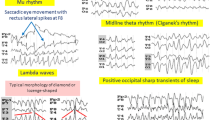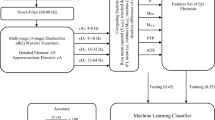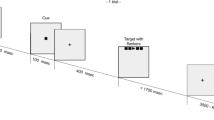Abstract
Purpose
Quantitative EEG measurement of sleepiness must be regarded both as fundamentally and practically important. In a search for the markers of physiological sleepiness, we tested whether the time course of self-perceived sleepiness/alertness correlates with the time courses of scores on principal components of the EEG spectrum.
Subjects and methods
The resting EEG was recorded in 15 healthy subjects with 2 h intervals in frontal and occipital derivations for the last 32–50 h of 44–61 h wakefulness. The correlation coefficients were calculated to test associations of the time course of self-perceived sleepiness/alertness with the time courses of spectral powers and scores on the two largest principal components of the EEG spectrum.
Results and conclusion
The results demonstrate that objective markers of sleepiness can be derived by means of principal component analysis of the EEG spectrum. A score on the 2nd principal component appears to be the most reliable correlate of sleepiness, because it exhibits the fastest decline at the boundary between wakefulness and sleep. A score on the 1st principal component was characterized by a decline before sleep onset followed by a rapid rise after it. These two scores were interpreted as the pure representatives of the wake and sleep drives, respectively, while spectral powers in separate frequency bands appear to reflect simultaneous influences of both drives.
Zusammenfassung
Einführung
Die quantitative EEG-Auswertung hat sowohl im grundsätzlichen als auch im praktischen Sinne eine große Bedeutung. Um physiologische Schäfrigkeitsmarker zu finden, haben wir untersucht, ob der Zeitablauf der subjektiven Schläfrigkeit/Wachsamkeit mit dem Zeitablauf von Parametern der Hauptkomponentenanalyse des aufgezeichneten EEG-Spektrums korreliert.
Personen und Methoden
Ein Ruhe-EEG wurde bei 15 gesunden Testpersonen mit frontalen und okzipitalen Ableitungen alle 2 h aufgezeichnet, wobei die letzten 32–50 h eines Schlafentzugs von 44–61 h herangezogen wurden. Korrelationskoeffizienten wurden errechnet, um den Zusammenhang des Zeitablaufs der subjektiven Schläfrigkeit mit dem Zeitablauf der spektralen Dichte und den 2 Hauptkomponenten des EEG-Spektrums zu testen.
Ergebnisse und Schlussfolgerung
Die Ergebnisse zeigen, dass objektive Schläfrigkeitsmarker mittels der Hauptkomponentenanalyse des EEG-Spektrums abgeleitet werden können. Der Wert der 2. Hauptkomponente scheint ein sicheres Korrelat der Schläfrigkeit zu sein, da dieser die schnellste Abnahme an der Grenze zwischen Wachen und Schlaf aufweist. Der Wert der 1. Hauptkomponente zeigt eine Abnahme vor dem Schlaf und ein schnelles Aufsteigen danach. Diese 2 Werte sind als reine Repräsentanten der Schlaf- und Wachregulation zu interpretieren, wohingegen die spektrale Dichte in getrennten Frequenzbändern die gleichzeitigen Einflüsse dieser Antriebe reflektiert.





Similar content being viewed by others
References
Achermann P, Borbely A (1994) Simulation of daytime vigilance by the additive interaction of a homeostatic and a circadian process. Biol Cybern 71:115–121
Åkerstedt T, Gillberg M (1990) Subjective and objective sleepiness in the active individual. Int J Neurosci 52:29–37
Ǻkerstedt T, Folkard S (1995) Validation of the S and C components of the three process model of alertness regulation. Sleep 18:1–6
Aeschbach D, Matthews JR, Postolache TT et al (1999) Two circadian rhythms in the human electroencephalogram during wakefulness. Am J Physiol (Regulatory Integrative Comp Physiol) 277:R1771–R1779
Borbély AA (1982) A two process model of sleep regulation. Hum Neurobiol 1:195–204
Cajochen C, Brunner DP, Kräuchi K et al (1995) Power density in theta/alpha frequencies of the waking EEG progressively increases during sustained wakefulness. Sleep 18:890–894
Czeisler CA (2011) Impact of sleepiness and sleep deficiency on public health: utility of biomarkers. J Clin Sleep Med 7(5 Suppl):6–8
Daan S, Beersma DGM, Borbély AA (1984) Timing of human sleep: recovery process gated by a circadian pacemaker. Am J Physiol (Regulatory Integrative Comp Physiol) 246:R161–R178
Dinges DF (1995) An overview of sleepiness and accidents. J Sleep Res 4(Suppl 2):4–14
Finelli LA, Baumann H, Borbely AA, Achermann P (2000) Dual electroencephalogram markers of human sleep homeostasis: correlation between theta activity in waking and slow-wave activity in sleep. Neurosci 101:523–529
Frigo M, Johnson SG (2005) The design and implementation of FFTW3. Proc IEEE 93:216–231
Leproult R, Colecchia EF, Berardi AM et al (2003) Individual differences in subjective and objective alertness during sleep deprivation are stable and unrelated. Am J Physiol (Regulatory Integrative Comp Physiol) 284:R280–R290
Lorenzo I, Ramos J, Arce C et al (1995) Effect of total sleep deprivation on reaction time and waking EEG activity in man. Sleep 18:346–354
Leger D (1994) The cost of sleep-related accidents: a report for the National Commission of Sleep Disorders Research. Sleep 17:84–93
Mitler MM, Carskadon MA, Czeisler CA et al (1988) Catastrophes, sleep, and public policy: consensus report. Sleep 11:100–109
Makeig S, Jung TP (1995) Changes in alertness are a principal component of the variance in the EEG spectrum. Neuroreport 7:213–216
Mullington JM, Czeisler CA, Goel N et al (2011) Panel discussion: current status of measuring sleepiness. J Clin Sleep Med 7(5 Suppl):22–25
Oken BS, Salinsky M (1992) Alertness and attention: basic science and electrophysiologic correlates. J Clin Neurophysiol 9:480–494
Putilov AA (2010) Principal component structure of wake-sleep transition: quantitative description in multiple sleep latency tests. Somnologie 14:234–243
Putilov AA (2011) Prospects of using electroencephalographic signatures of the chronoregulatory processes for meaningful, parsimonious and quantitative description of the sleep-wake sub-states. Biol Rhythm Res 42:181–207
Putilov AA (2011) Principal components of electroencephalographic spectrum as markers of opponent processes underlying ultradian sleep cycles. Chronobiol Int 28:287–299
Putilov AA, Donskaya OG, Verevkin EG et al (2009) Chronotype, somnotype and trototype as the predictors of the time course of subjective and objective indexes of sleepiness in sleep deprived subjects. In: Fulke P, Vaughan S (eds) Sleep deprivation: causes, effects and treatment. Nova Science, New York, pp 95–142
Putilov AA, Donskaya OG, Verevkin EG, Shtark MB (2009) Structuring the inter-individual variation in waking EEG can help to discriminate between the objective markers of sleep debt and sleep pressure. Somnologie 13:72–88
Quan SF (2011) Finding a research path for the identification of biomarkers of sleepiness. J Clin Sleep Med 7(5 Suppl):4–5
Quan SF, Shaw PJ, Naidoo N et al (2011) Panel discussion: can there be a biomarker for sleepiness? J Clin Sleep Med 7(5 Suppl):45–48
Samkoff JS, Jacques CH (1991) A review of studies concerning effects of sleep deprivation and fatigue on residents’ performance. Acad Med 66:687–693
Stampi C, Stone P, Michimori A (1995) A new quantitative method for assessing sleepiness: the alpha attenuation test. Work and Stress 9:368–376
Strijkstra AM, Beersma DG, Drayer B et al (2003) Subjective sleepiness correlates negatively with global alpha (8–12 Hz) and positively with central frontal theta (4–8 Hz) frequencies in the human resting awake electroencephalogram. Neurosci Lett 340:17–20
Van Dongen HPA (2006) Shift work and inter-individual differences in sleep and sleepiness. Chronobiol Int 23:1139–1147
Acknowledgments
The experiments were supported by the grants from the Russian Foundation for Basic Research and the Russian Foundation for Humanities (07-06-00263а, 08-04-01071-а, 10-06-00114-а, and 06-06-00375-a).
Conflict of interest
No statement made.
Author information
Authors and Affiliations
Corresponding author
Rights and permissions
About this article
Cite this article
Donskaya, O., Verevkin, E. & Putilov, A. The first and second principal components of the EEG spectrum as the correlates of sleepiness. Somnologie 16, 69–79 (2012). https://doi.org/10.1007/s11818-012-0561-1
Received:
Accepted:
Published:
Issue Date:
DOI: https://doi.org/10.1007/s11818-012-0561-1




